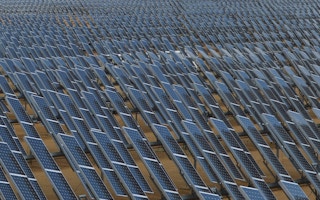As countries around the world ramp up climate action by adopting clean energy on a larger scale, about 15 million new green jobs could be created in the sector by the end of this decade, REN21, a Paris-based think-tank on renewables, said this week.
The policies driving this employment include the US Inflation Reduction Act aimed at boosting clean technologies and the European Union’s “REPowerEU” proposal to adopt more renewables and end reliance on Russian fossil fuels before 2030.
Some 15 more countries - including Canada, India, three African nations and others in Southeast Asia - are due to expand renewables and related jobs, REN21 estimated in a new report.
Global uptake of renewables like solar and wind power after the 2015 Paris climate agreement increased the number of clean energy jobs around the world to 12.7 million by 2021, according to International Renewable Energy Agency data.
But if the new jobs expected this decade are to make up for the millions that will be lost due to a phase-down in fossil fuel production and use, they need to be long-term and supported by re-skilling, pensions and better pay, analysts said.
“
The new green jobs will have to address these challenges for a just transition of workers that are set to lose their livelihoods in the fossil-fuel sectors.
Sandeep Pai, research director, Swaniti Initiative
Here’s how clean energy employment could shape up in the coming years:
What challenges have clean energy jobs met so far?
While jobs have increased in recent years - especially in the solar power sector which employs about 4.3 million people - there are questions about their quality.
Much of the employment has been temporary, involving workers constructing renewable energy parks for short periods at low rates of pay, said Sandeep Pai, research director at the Swaniti Initiative, an Indian policy think-tank.
Often these new jobs have been located far from the places where fossil-fuel workers have been laid off, making it hard for them to move between the two.
For example, India’s clean energy jobs are emerging in western and southern areas, while coal workers are located in the east - and China is facing a similar issue, Pai said.
“The new green jobs will have to address these challenges for a just transition of workers that are set to lose their livelihoods in the fossil-fuel sectors,” Pai added.
Rana Adib, executive director of REN21, said renewable energy jobs could be made more attractive and accessible if governments and business invested in training and education.
Some countries - including the United States, Australia and China - are already doing this by creating funds for skills development and compensating workers who lose jobs in the coal industry.
Raising public awareness about the importance of green jobs, and their benefits for the environment and the economy, through media campaigns, education programmes and partnerships with community groups could also help, said Adib.
“A positive public perception of green jobs can also lead to increased support for related policies and initiatives,” she added.
What kind of clean energy jobs will be created?
A growing number of countries have committed to weaning their energy systems off fossil fuels and onto cleaner sources in the coming decades, to reach net-zero greenhouse gas emissions by mid-century.
While this transition will lead to job losses in the coal, oil and gas sectors, it is projected to result in a global net gain in employment, with more jobs created by ramping up renewables capacity than are lost by reducing fossil fuels, the REN21 report said, without giving a specific figure.








